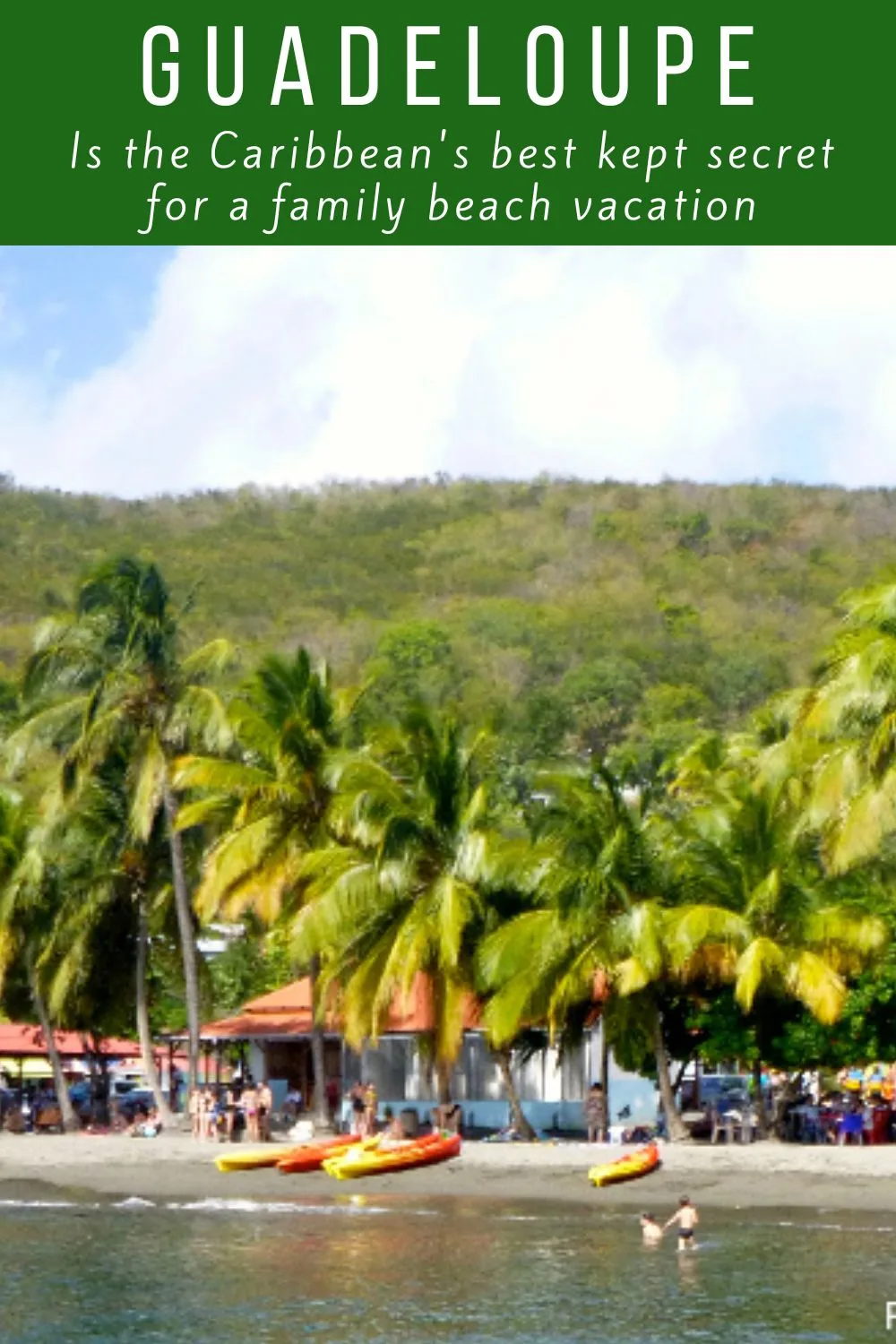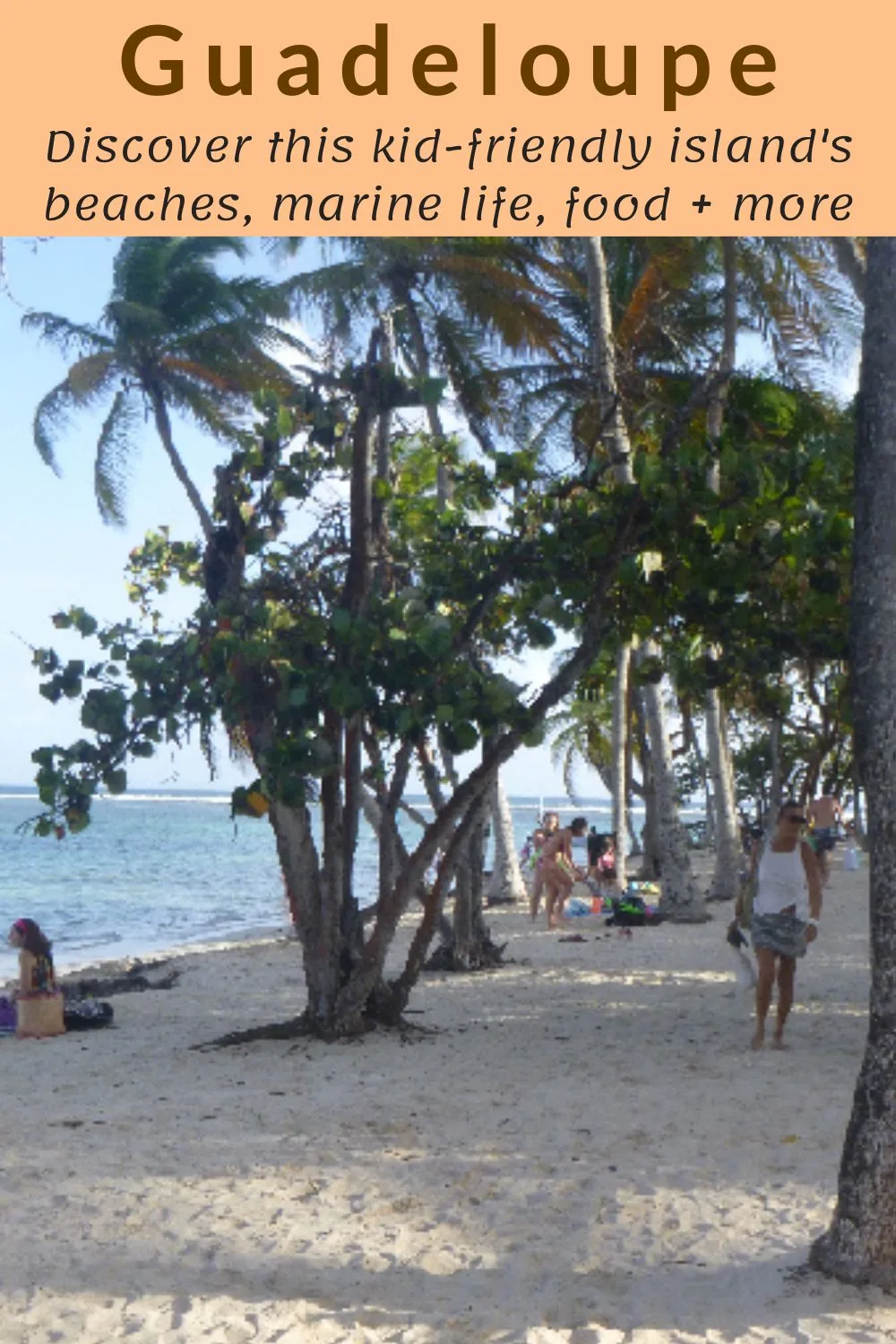Like many American sun-seekers I had never heard of the Caribbean Island of Guadeloupe. Then a Guadeloupian mom at my daughter’s school told me about the rainforests, waterfalls and volcanoes, beautiful beaches, world-class marine reserve, and French-creole cuisine.
It sounded like Hawaii with Creole cooking and a much shorter plane ride, and there is absolutely nothing bad about that. So when friends spotted a very good package deal there, I jumped at the chance to head ther for a winter-break vacation. It’s a nice off-the-beaten-track option for spring break, too.
It was every bit as scenic and easy to like as I had hoped. And with Guadelope standing in for Saint Marie in the murder-mystery show Death in Paradise, the secret is getting out.
Here are the key things you want to know to plan a vacation with kids on Guadeloupe’s two main islands of Grand-Terre and Basse-Terre.
Read More:
• The Best Things To Do See & Eat in Curacao With Kids
• How Families Chill Out at Curacao’s Mangrove Beach Resort
• 5 Turks & Caicos Outings That Teens Love
Guadeloupe: Discover This Caribbean Island For An Awesome Beach Vacation With Kids
1. Guadeloupe resorts are local and lovely
We didn’t see many brand-name mega resorts on Gaudeloupe, and I think this is a good thing. Our experience was comfortable and also felt authentic.
La Creole Beach Hotel & Spa, where we stayed, seemed typical of the hotels you find on Guadeloupe: A colorful boutique resort on its own small stretch of beach. It had everything we wanted and was compact enough that we didn’t need to walk far for anything.
There are not many full-on all-inclusives in Guadeloupe, but in the European style La Creole include a very good breakfast buffet in the room rate. You can opt to have dinner included in your stay, too, if you want to keep things simple. This seems to be the typical arrangement.
We found plenty of friendly, inexpensive restaurants with good food within a few minutes’ walk of the hotel and didn’t have dinner there at all.
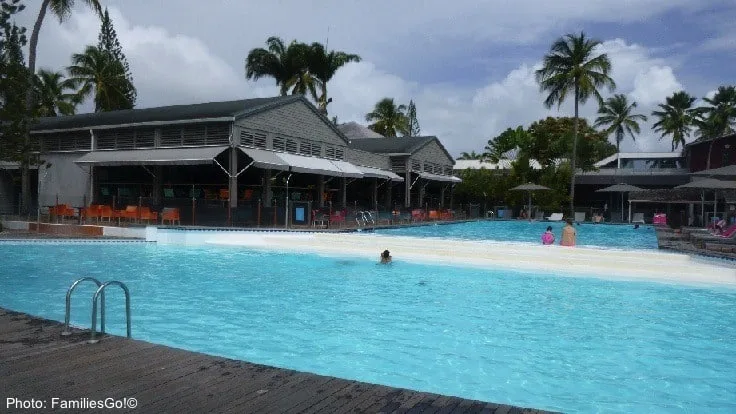
The resort had a good-sized pool, a beach, a casual restaurant where we could get burgers and sandwiches for lunch, live music at night, a water-sports desk and an excellent kids’ club. It had only a few hundred rooms, a local feel and real charm.
At the Ti-Moun kids club there were usually 6-to-10 kids and three adults. A big, friendly counselor with dreadlocks always greeted my daughter by name.
I’m not sure how well-equipped they are for kids to stay for all or a good part of the day. But for an hour or two to break up the day and get Tiny Traveler out of the sun, it was great.
One day the kids colored sand with paint and did art with it; on another, they made crocodiles with lanyards and beads. The counselors did speak English, but Tiny Traveler was the only English-speaking kid there. Still, she played Uno in French with the other kids (the cards are basically the same).
2. Your All-inclusive Resort Option
Club Med La Caravelle is pretty much your only option for a complete all inclusive. It’s on a pretty, palm-tree lined stretch of beach with a small outcropping of rocks for handy snorkeling.
It’s close to Sainte-Anne, a lively beach town with a daily market where you can buy souvenirs including local spices or some of the madras plaids you see on everything from tablecloths to dresses.
The resort’s beach leads seamlessly into the popular public Plage Caravelle, which provides a nice long stretch of beach to explore, but does take away from the resort’s exclusivity a little bit.
Guadeloupe is an easy place to explore with a lot to see. Even if you do go the all-inclusive route pull yourself away from the resort’s many offerings and go on a few excursions.
3. Guadeloupe has gorgeous scenery
It’s essential to spend a day exploring rain-forest-covered Basse-Terre.
Hiking to the top of La Soufrière volcano and back takes three to four hours. We thought it would take too much of our limited time with a car rental. But other parents at the resort told us their 10YOs loved it and it wasn’t as challenging as they expected.
The volcano, hot springs and big waterfalls in the south are all away from the main road and don’t connect to one another. If you do this excursion, plan for a long but no doubt worthwhile day. Bring plenty of water, snacks and a picnic lunch.
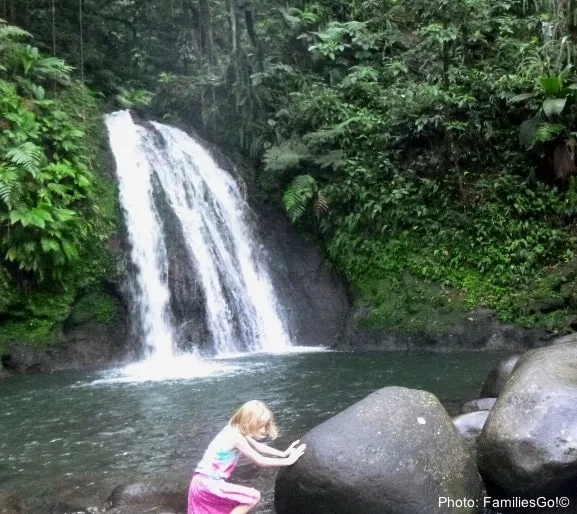
We drove across the island’s middle, stopping to wade in a small waterfall and then heading to Plage de Malendure (top) and Pigeon Island, which is known for amazing sea-life (more on that further down).
We hoped to visit a chocolate plantation, too, but we ran out of daytime too quickly.
Planning a Guadeloupe vacation?
• How about renting a house with a private pool and sea view.
Reserve rooms at La Creole Beach Resort
• Check Expedia for airfare-and-hotel packages.
• I strongly advise reserving a car ahead of time during school breaks.
4. Guadeloupe has lovely beaches everywhere
The beaches are small, but they all have a secluded cast-away island feel and are both varied and scenic. Malendure was a volcanic black-sand beach and some of the smaller out islands have pink sand. Grand-Terre had mostly white-sand beaches.
The water off of Plage Malendure on the coast of Basse Terre was calm but all we had time for was a quick dip. Chairx or a thick blanket are essential if you plan to hang out because the black sand heats up more than regular sand does.
We did a coastal drive along Grand-Terre, stopping for a beachside lunch in stylish Saint-Francois before taking in the crashing waves and scenic rocks at Pointe de Chateau. We then headed to Saint-Anne’s very popular (with good reason) Plage Caravelle.
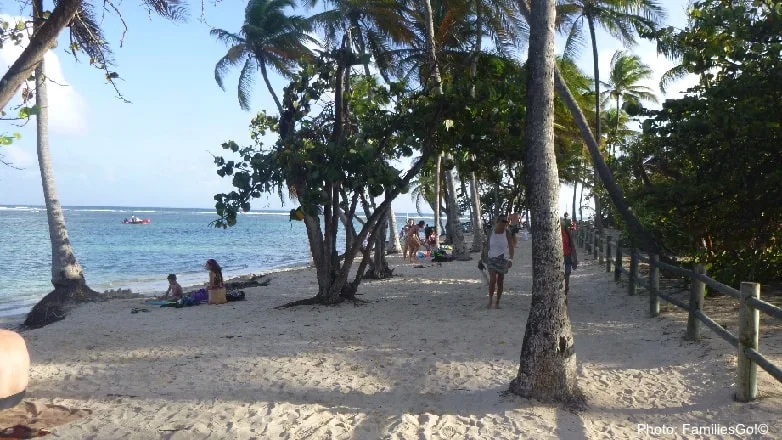
Its skinny stretch of sand is interspersed with palm trees and shrubs that give it a castaway island feel and obscure all the people sunbathing and swimming just a few feet away.
Plage Carevelle also provided the best and easiest (and free) snorkeling for us. There is a stone jetty where the public beach runs into Club Med’s and the snorkeling was fantastic. We were nose-to-nose with schools of fish in all kinds of colors, swimming, eating and sleeping.
Tiny Traveler was not having a lot of luck using a snorkel but here the water was so shallow she just put goggles on and stuck her head in the water.
The water is calm and vendors sell inexpensive pocket pies and donuts. We parked in someone’s backyard for a few Euros and it was money well spent.
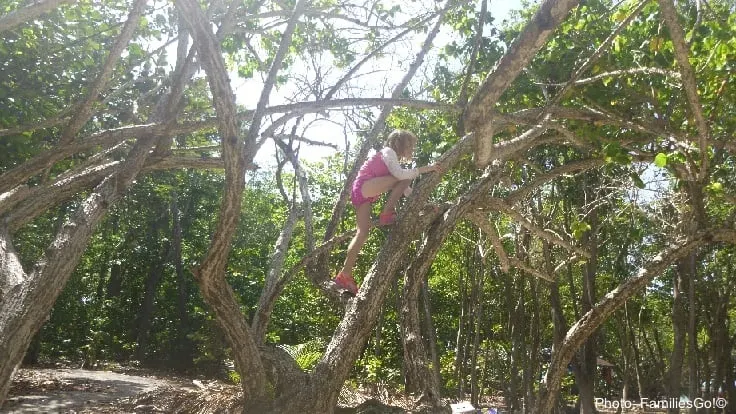
We also took wave runners from our hotel to Islet Gosier one day and that was easy, relaxing and fun.
Locals tie up hammocks and barbecue while tourists eat rice with grilled chicken or fish that had been caught a few minutes earlier at a very casual fish shack.
Castaway-island beaches ring the exterior, while the interior is full of bent-over trees made for climbing. The island is about the size of a city block, so kids can’t get lost if they wander off on their own.
You can snorkel here, but you have to avoid the prickly sea urchins and the fish aren’t that plentiful.
5. Guadeloupe has an enormous Marine Reserve
Jacques Cousteau did a lot of his SCUBA diving and sea exploration around Pigeon Island, off the coast of Plage Malendure. The island is part of a 400-hectare marine reserve that is fed by warm volcanic springs.
It’s a hotbed — literally — for marine flora and fauna. We couldn’t visit Malendure without taking a peek under the water.
We wanted to make sure the kids would see plenty of sea life. So we took a glass-bottom boat and snorkel tour on the Nautilus and loved it.
Rather than the glass floor above the water that we expected, the hull is glassed in so you can be in the boat and underwater. The views were so good we almost didn’t need to snorkel.
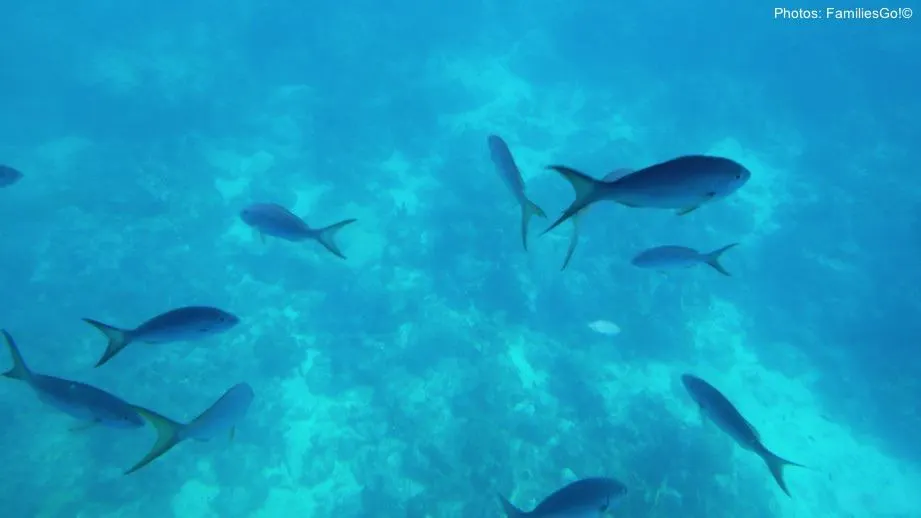
Tiny Traveler didn’t want to snorkel but she stayed in the glass hull every last second of the ride. She saw tons of fish, turtles and divers. She even saw us snorkeling
The snorkeling itself was a mixed experience. The reefs are deep, but the water is very clear and visibility is amazing. You can see all the activity going on far below.
But you are out in open water and the sea is rough. We didn’t go far from the boat because we didn’t want to have to swim hard to get back. Our friend’s 7YO did snorkel, with very close supervision, and liked it.
Tip: if your kids aren’t good swimmers, bring a real swim vest with you. It helps a lot, and you can’t count on boat operators to have them.
Bring your own snorkel gear if you have it, too. You’ll have it for impromptu snorkeling off the beaches. But on top of that, the gear we saw on the boat was not impressive.
Note: I’ve read that since we visited, global warming has taken a toll on the islands’ reefs. Fish are still plentiful but in some spots the coral isn’t what it used to be,
6. Guadeloupe has delicious food
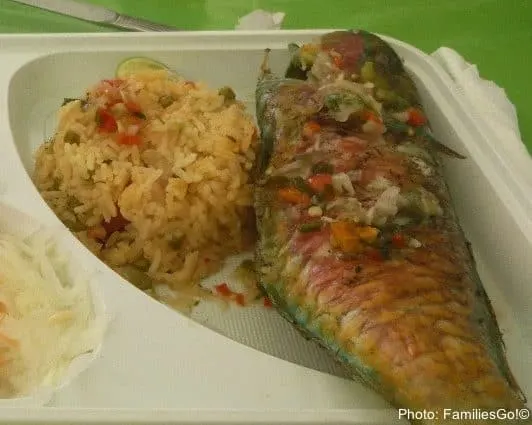
We chose restaurants entirely at random and did not have a single bad meal. We felt the tabs for food, and especially drinks, were reasonable, especially for the Caribbean.
Local fish usually came with rice and salad. Fish soup was good, grilled chicken was reliable, and a good kids’ choice, accras (cod fritters) were addictive.
We had excellent Senegalese food near the hotel and a gorgeous view with our meal in Malendure. Ice cream was reliably good and we ate it daily.
We didn’t see a lot of take-away options, but if you don’t want to spend an hour eating lunch, keep your eye out for one of several Leader Price supermarkets. The take-out shop that’s always next door has excellent rotisserie chicken.
Casino supermarkets are full of French breads, cheeses and cold cuts for picnics.
7. Guadeloupe has Pointe-A-Pitre’s markets
The main city of Pointe-a-Pitre is full of dilapidated colonial charm, with a heavier accent on the dilapidated than I expected.
But it’s worth taking a morning to visit the markets and shop. We saw all kinds of Madras plaids in fun sunhats and sun dresses; we of course brought some back.
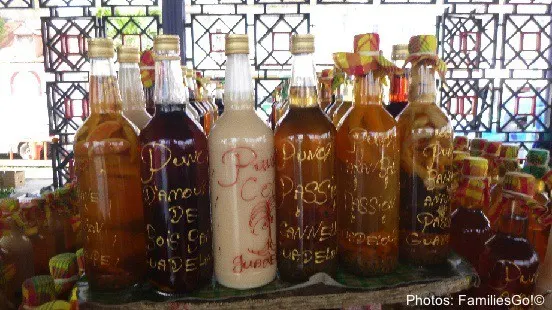
The open-air market and spice market are full of cinnamon sticks, vanilla pods, mulling spices and fresh Caribbean fruit like tiny red bananas. We even saw fresh peppercorns still in their furry pods.
Homemade concoctions of vanilla, fruit, spices and rum are pretty, but I think you’d have to be a brave person to buy them.
There is the huge Memoiral ACTe Museum of Slavery in an architecturally outstanding modern building on the water. The topic is a serious for a beach vacation, but I still wish we’d made time to visit it.
We are still struggling in the U.S. over whether and how to honor and teach this ugly part of our history. So I wanted to see how the people here are tackling this chapter of their past head on.
Some of the written material on the exhibits is in French only. But you can get audio guides that offer several different languages.
There are several other sites on the islands that honor local Afro-Caribbean history, if this is something you’d like to explore.
8. Guadeloupe has a must-see Colonial Hotel
For spiffed up colonial charm, take an adult-only hour and have a drink at the bar of Auberge de la Vielle Tour in Gosier.
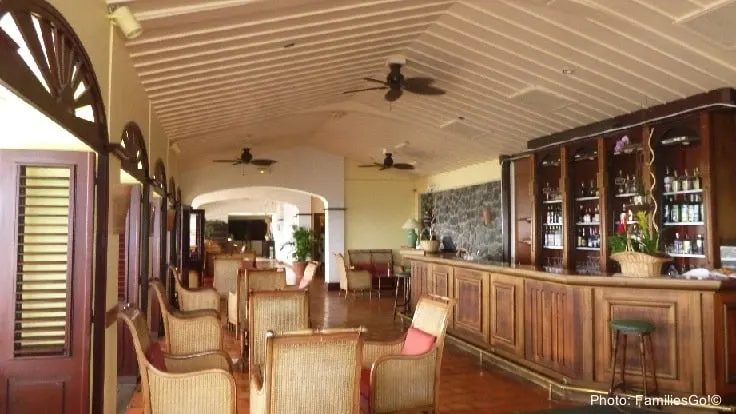
Built around an 18th century windmill, it’s all dark wood, subdued colors and local art. Head to the bar, settle into rattan chairs by the open windows and enjoy a punch planter and as the ceiling fans swirl slowly above.
Not even the ceiling fans are in a hurry on this island, which was just fine with us. We would hurry back to explore it further anytime.
9. Basic Information for a Guadeloupe Vacation
Flying to Guadeloupe
The French and Dutch Caribbean islands have fewer flights from the U.S. and Canda than islands further north. But from November to April you should be able to find flights that suit you fairly easily.
Jet Blue has direct flights from New York City to the capital city of Pointe-A-Pitre several times a week from November through April. Air France and American Airlines have year-round flights from Miami, which is a pretty easy connection to make. And Air France and Air Canada have year-round flights from Montreal.
It was a 25-minute drive from Pointe-A-Pitre International Airport to La Creole Resort. Saint-Ane, where Club Med is located, is about a 35-minute drive. Many hotels will arrange transfers and it’s easy to hail a cab.
Language and currency on Guadeloupe
Guadeloupe is a French territory so French is the primary language. Most people you will encounter in hotels, restaurants and tourist attractions speak at east some English annd communicating wasn’t a problem.
Euros are the local currency and unlike many islands they don’t accept dollars. If you can buy some before you leave it will be handy. But you’ll find ATMs at the airport in the towns. and credit/debit cards are widley accepted.
You’ll also need a European adapter for the electrical outlets.
Driving on Guadeloupe
Driving in Guadeloupe is pretty easy. Signs were clear, roads were good and local drivers followed rules we recognized.
We were told repeatedly that from our hotel in central Gosier it was an hour to the islands’ furthest points. But that timing does not account for the steep and winding one-lane roads on rain-forested Basse-Terre or the congestion in the popular tourist towns on Grand Terre.
We saw maybe two-thirds of what we hoped to each day. We could have used two more days to do all the sightseeing we wanted to and still have pool time.
Book a car before you leave, especially if you won’t keep it for your whole trip and want to pick it up close to your hotel. It will be cheaper and, especially during busy school-break weeks, you won’t have to worry about the rental agencies selling out.
We managed to do a last-minute rental and had to call around to find a location that had a car for us.
Adapting to Island-Time
Guadeloupe, like most of the Caribbean, runs on island time.
If you sit down to a meal, plan to be there for an hour or two. If your rental car is scheduled to arrive at 9:00, it will roll up at 10:00. Fresh towels will arrive at the pool and your room eventually.
It’s easy to complain that the service is indifferent or neglectful, but it really isn’t. Everyone we interacted with was friendly and helpful. They just aren’t in a hurry and assume you aren’t either (you are on vacation after all).
You pour a second cup of good local coffee while you wait for your car to show up. You order a planter’s punch with your lunch knowing you can linger over it. You hang your towel up to dry and relax with a book. It’s all good.
What to Pack for Guadeloupe
For the resort, you’ll want your bathing suit and a cover-up and plenty of water-resistant, reef-safe sun screen. Have a light hoodie or sweater for evenings, though we didn’t need them. A rash guard is handy to avoid a sun-burned back if you go snorkeling.
Most of the other guests will be European and, to be honest Europeans dress up more than Americans are inclined to these days. Shorts or Capri pants and t-shirts were fine for the casual restaurants near La Creole resort where we ate most of our dinners.
In the resort dining rooms, expect to see collared shirts for men and dresses for women once the sun starts to set. Even if places don’t explicitly prohibit flip-flops, I would have sandals handy to wear to dinner and sandals or sneakers for walking around Point-A-Pitre or the other towns.
Pin it for later!
